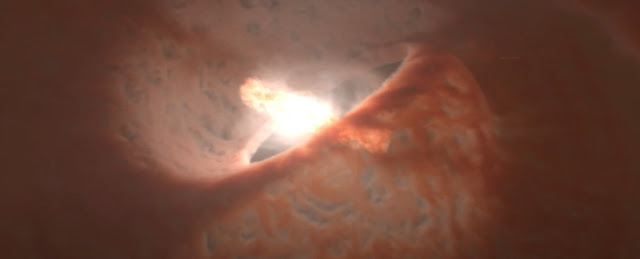 |
Artistic impression of GW Orionis. (European Southern
Observatory) |
Our Solar System, with just one star in the sky, may be a bit of an oddball. Most of the stars in the Milky Way galaxy actually have at least one gravitationally bound stellar companion, meaning that two-starred worlds like Tatooine are probably not uncommon.
Star systems, however, are not confined to a maximum of two
stars. We've found systems of up to seven stars bound together in a complex
orbital dance. And now, scientists have found what they believe may be a first
for astronomy: an exoplanet orbiting a system of three stars, also known as a
stellar trinary.
To be clear, exoplanets have been found in trinary systems
before – orbiting just one of the stars in the system. If this new discovery is
validated, though, the exoplanet will be in orbit around all three of the
stars, which isn't something that's been seen previously.
 |
Observations of GW Orionis. (ALMA (ESO/NAOJ/NRAO),
ESO/Exeter/Kraus et al.) |
Stars in the Milky Way are not usually born in isolation.
Their birthplaces are massive molecular clouds, where dense clumps of gas
collapse under gravity.
As these clumps spin, material in the cloud forms a disk
that accretes onto the forming star. If this disk fragments, another star, or
multiple stars, can start forming in the same place – a little stellar family
of siblings. After the star is done forming, what's left of the disk can go on
to form planets.
It's estimated that some 40 to 50 percent of stars have a
binary companion, and another 20 percent are in systems that have three or more
stars.
These systems will be quite gravitationally complex, which
may make it difficult for smaller objects to stick around – but nevertheless,
around 2.5 percent of exoplanets are estimated to be in these multiple systems
consisting of three stars or more.
To date, around 32 exoplanets have been found in trinary
systems. And then a system called GW Orionis came along.
Located about 1,300 light-years away, GW Orionis caught
astronomers' attention because it's surrounded by a huge, misaligned
protoplanetary disk circling all three stars.
Using the powerful Atacama Large Millimeter/submillimeter
Array (ALMA), astronomers confirmed something else about the system: There's a
substantial gap in the protoplanetary disk.
According to our models of planet formation, gaps in
protoplanetary disks are likely to be caused by planets forming. As they go
around the star, these planets sweep up the dust and gas in their orbital path,
clearing it and leaving a gap.
In GW Orionis, things aren't necessarily so clear-cut.
Because the three stars would generate a complex gravitational field, there's a
possibility that any strange features in the disk could have been created by
the stars themselves.
Previous analysis suggested that this is probably not the
case; the gravitational interaction between the stars alone is not sufficient
to have carved a gap in the disk, leaving a forming exoplanet as the likely
explanation.
Now, a new analysis has agreed with this interpretation. Led
by astronomer Jeremy Smallwood of the University of Nevada, Las Vegas, a team
of researchers reconstructed a model of the GW Orionis system, integrating
N-body and three-dimensional hydrodynamic simulations.
They found, just as researchers before them had, that the
torque generated by the stars is not sufficient to have split the
protoplanetary disk.
Instead, the culprit is likely a gas giant, like Jupiter, in
the process of forming, or perhaps multiple gas giants. We've not seen the
exoplanet itself, which means there's still room for doubt, but the agreement
between the two separate research efforts does seem to favor the baby exoplanet
interpretation.
Which could mean that the planet formation process might be
able to survive more extreme conditions than we expected, such as complicated
environments like the space around triple stars.
"It's really exciting because it makes the theory of
planet formation really robust," Smallwood said. "It could mean that
planet formation is much more active than we thought, which is pretty
cool."
The team hopes that astronomers will be able to see the
exoplanet or exoplanets directly in upcoming observations of the GW Orionis
system.
Reference: Monthly Notices of the Royal Astronomical Society




0 Comments